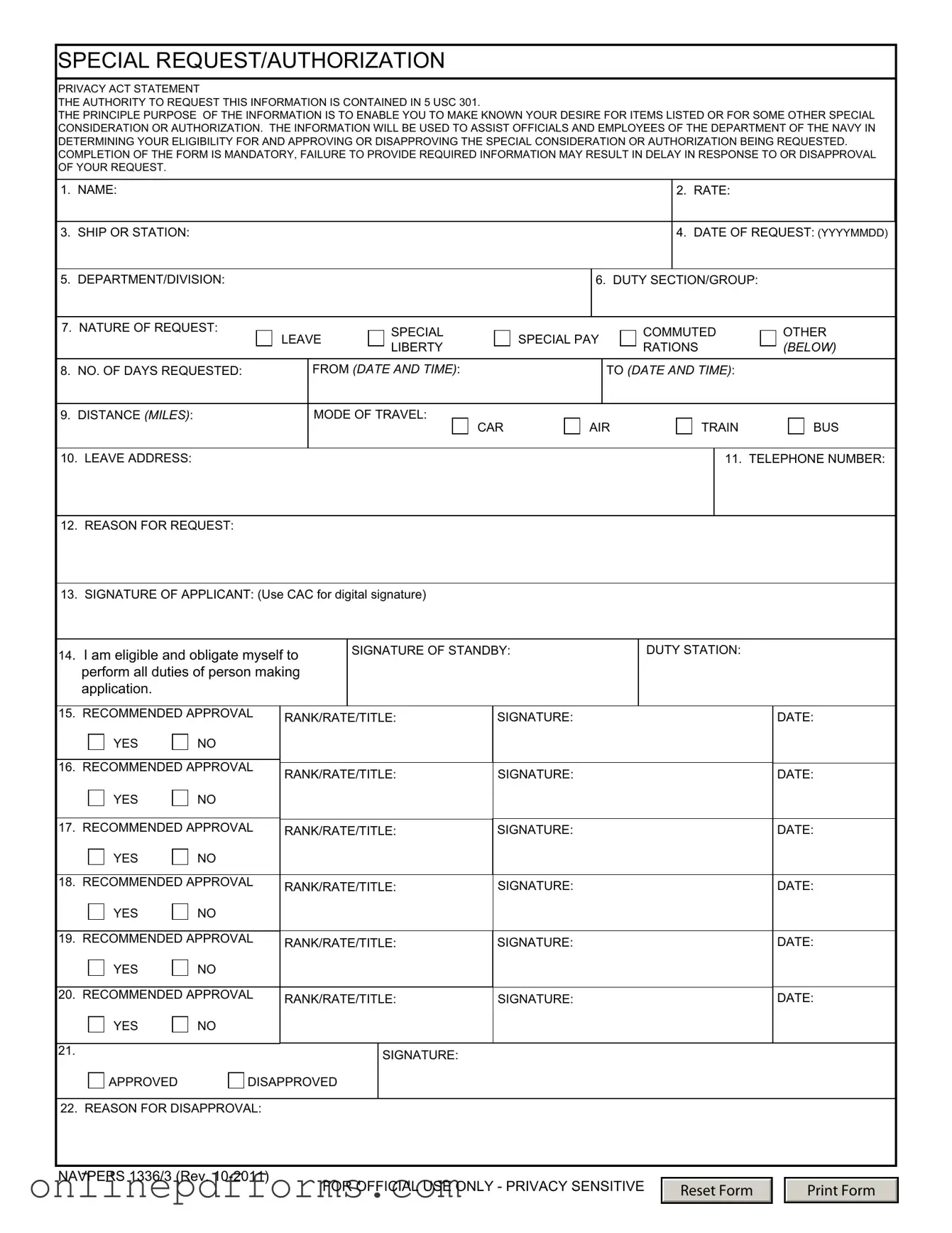The DD Form 149, Application for Correction of Military Record, serves a similar purpose to the NAVPERS 1336/3 in that both forms allow individuals to request specific considerations from military authorities. While the NAVPERS 1336/3 focuses on special requests such as leave or special pay, the DD Form 149 is used to seek corrections to military records, including changes to discharge status or personal information. Both forms require detailed personal information and signatures for approval, emphasizing the importance of accurate documentation in military processes.
The DA Form 31, Request and Authority for Leave, is another document that parallels the NAVPERS 1336/3. This form is specifically used by Army personnel to request leave. Like the NAVPERS 1336/3, it requires information about the individual’s unit, the type of leave requested, and the duration. Both forms necessitate approvals from commanding officers, highlighting the structured process of leave requests within military branches.
The AF Form 988, Leave Request/Authorization, is similar to the NAVPERS 1336/3 in that it is utilized by Air Force members to formally request leave. This form captures essential details such as the type of leave, duration, and reason for the request. The structured nature of both forms ensures that military personnel provide the necessary information for their requests to be processed efficiently, reinforcing the importance of following protocol in all branches of the military.
The SF 50, Notification of Personnel Action, is another document that shares similarities with the NAVPERS 1336/3, particularly in its role in documenting personnel actions. While the NAVPERS 1336/3 is focused on requests for special considerations, the SF 50 records changes in employment status, including promotions or leave. Both documents require official signatures and are crucial for maintaining accurate personnel records within military and government systems.
The DD Form 214, Certificate of Release or Discharge from Active Duty, also shares a connection with the NAVPERS 1336/3 as it is a critical document for military personnel transitioning out of service. While the NAVPERS 1336/3 deals with requests for special considerations during service, the DD Form 214 provides a summary of a service member's military career, including the nature of discharge. Both forms emphasize the importance of formal documentation in military operations.
The NAVPERS 1070/613, Administrative Remarks, is another related document. This form is used to record various administrative actions, including special requests and approvals. Similar to the NAVPERS 1336/3, it requires signatures from the individual and approving authorities. Both forms play a role in documenting important actions and decisions made within the military, ensuring that records are maintained accurately.
The NAVPERS 1616/26, Evaluation Report and Counseling Record, serves a different purpose but is similar in its formal structure and requirement for approval. While the NAVPERS 1336/3 focuses on special requests, the NAVPERS 1616/26 is used for documenting performance evaluations. Both forms require input from the individual and their superiors, reinforcing the importance of accountability in military service.
The SF 86, Questionnaire for National Security Positions, is another document that, while focused on security clearances, parallels the NAVPERS 1336/3 in its requirement for detailed personal information and formal approvals. Both forms are critical for ensuring that individuals meet the necessary criteria for their roles within the military, highlighting the importance of thorough documentation and review processes.
For individuals needing to register their vehicles temporarily, understanding the required documentation is essential. The Texas Temporary Tag form allows for lawful operation of your vehicle while you await permanent registration. This form plays a critical role not just for private vehicle owners but also for dealerships ensuring compliance with state regulations. To simplify the process further, you can access the Quick Vehicle Tag Form for your needs.
Lastly, the NAVPERS 1070/602, Dependency Application/Record of Emergency Data, is similar in that it collects personal information necessary for military personnel. This form is used to establish dependents and emergency contact information, while the NAVPERS 1336/3 focuses on special requests. Both forms require accuracy and completeness to ensure that the military can effectively support its personnel and their families.
